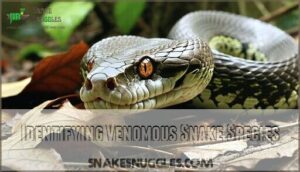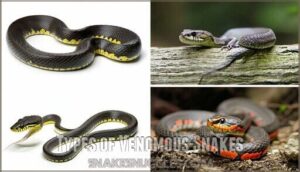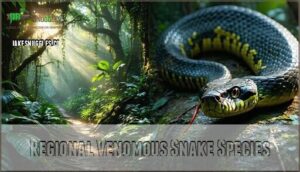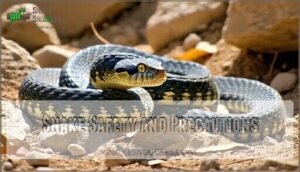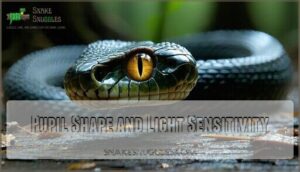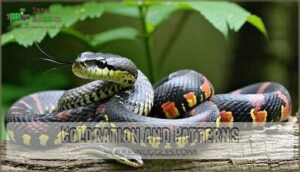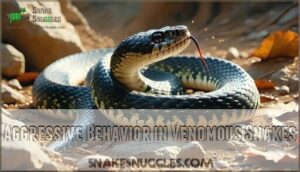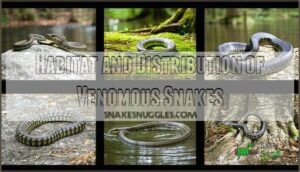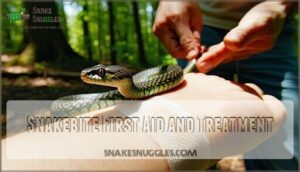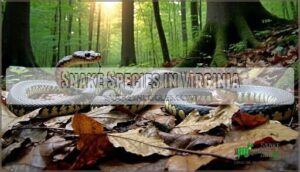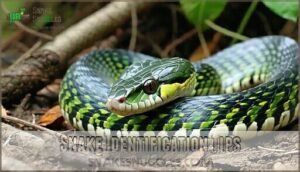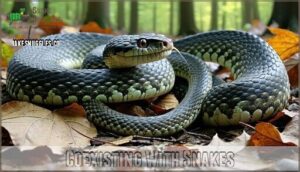This site is supported by our readers. We may earn a commission, at no cost to you, if you purchase through links.
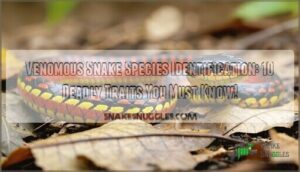
Triangular heads, slit-like pupils, and heat-sensing pits between their eyes and nostrils are classic clues.
Many have bold patterns, like rattles on a rattlesnake or the coral snake’s red, yellow, and black rings (remember: “Red touch yellow, dangerous fellow”).
Their behavior can also give them away—some species coil defensively or rattle a warning.
But don’t rely on just one trait; misidentifying could lead to danger.
Always keep your distance and observe calmly.
Understanding these details can be the key to staying safe in snake territory.
Table Of Contents
- Key Takeaways
- Identifying Venomous Snake Species
- Types of Venomous Snakes
- Regional Venomous Snake Species
- Snake Safety and Precautions
- Snake Head Shape and Features
- Snake Behavior and Habitat
- Snakebite First Aid and Treatment
- Snake Species in Virginia
- Snake Identification Tips
- Coexisting With Snakes
- Frequently Asked Questions (FAQs)
- Is there a snake app to identify snakes?
- Can I upload a picture of a snake to identify it?
- How do you identify a venomous snake in Virginia?
- How many venomous snakes are there?
- Are there venomous snakes in Virginia?
- What does a snake have in common with a non venomous snake?
- How do climate changes affect snake behavior?
- What myths about snakes are mostly false?
- How do snakes communicate with each other?
- What are common snake behaviors during winter?
- Conclusion
Key Takeaways
- Look for triangular heads, slit-like pupils, and heat-sensing pits to spot venomous snakes.
- Pay attention to bold patterns like rattles, hourglass markings, or the red-yellow-black rings of coral snakes.
- Venomous snakes often display defensive behaviors like coiling, rattling, or gaping their mouths.
- Stay calm, keep your distance, and identify regional species to ensure your safety outdoors.
Identifying Venomous Snake Species
You’ll need to recognize critical markers like triangular heads, heat-sensing pit organs, and vertical pupils to identify venomous snakes in the wild.
Knowing these distinctive traits, along with regional species characteristics, could mean the difference between a safe encounter and a potentially life-threatening emergency.
Recognizing distinct traits and regional snake species can turn a dangerous encounter into a safe and informed outdoor experience.
Characteristics of Venomous Snakes
Several venomous snakes share distinctive characteristics you should recognize.
Look for triangular-shaped heads, vertical pupil slits (like a cat’s eye), and heat-sensing pit organs between the eye and nostril.
Scale patterns often include unique markings like diamonds or bands.
Venomous species typically have shorter, stockier bodies with specialized venom delivery systems.
Their venom potency varies by species, with some having neurotoxic effects while others destroy tissue.
Remember, snake size isn’t always an indicator of danger.
Common Traits of Non-Venomous Snakes
Unlike their venomous cousins, non-venomous snakes display distinctive identifying features.
You’ll notice round pupils instead of vertical slits, and smoother, more slender body shapes.
Their scale patterns typically lack dramatic markings, appearing more uniform.
These gentler species also exhibit calmer temperaments and different diet habits, primarily consuming small rodents and insects.
They also play a crucial ecological role by controlling rodent populations.
When practicing snake identification, these traits form your essential snake identification guide to safely distinguish harmless snake species from dangerous ones, and understand their crucial ecological role in the ecosystem, which is vital for maintaining a balanced environment.
Importance of Accurate Identification
A coiled serpent crosses your path during a hike—is it friend or foe? Accurate snake identification isn’t just fascinating—it’s potentially lifesaving. Understanding the difference between venomous and non-venomous species directly impacts bite severity and treatment efficacy.
Accurate snake identification transforms fear into confidence, ensuring safety and fostering a deeper appreciation for these fascinating creatures.
Misidentification risks work both ways: you might panic unnecessarily over a harmless snake or, more dangerously, dismiss a venomous one as harmless. Many non-venomous snakes have evolved to mimic their dangerous counterparts as a survival strategy.
Regional knowledge matters too. A venomous snake identification guide specific to your area helps you recognize local threats. This awareness supports both public safety and conservation efforts.
When you’re confident in identifying snakes, you’ll make better decisions during encounters—knowing when to back away slowly and when emergency medical attention is critical.
Types of Venomous Snakes
You’ll encounter four main types of venomous snakes in the United States: cottonmouths, rattlesnakes, copperheads, and coral snakes, each with distinct identifying features that can save your life.
While they’d rather avoid you than bite, knowing how to recognize these species by their characteristic triangular heads, heat-sensing pits, and distinctive coloration patterns is essential for your safety in the wild, which involves understanding their distinctive coloration patterns.
Cottonmouths (Water Moccasins)
A cottonmouth, also called a water moccasin, thrives in marshy areas and is easy to identify with its wide mouth that flashes a white "cotton" interior when threatened.
These carnivorous pit vipers love basking near water, hunting fish and amphibians. Watch for their distinct behaviors during spring breeding season. Stay safe by keeping your distance! Cottonmouths aren’t typically aggressive, but will display their white mouth when threatened, and also combine ambush predation with active foraging, but cottonmouths’ behavior is highly adaptable.
- Venom is potent, causing tissue damage.
- Dark, heavy bodies, often with faint bands.
- Triangular-shaped heads, typical of pit vipers.
- Mostly found in swamps, ponds, and stream edges.
Rattlesnakes
Rattlesnakes stand out among venomous snakes with their iconic tail rattles that serve as nature’s warning system.
These distinctive reptiles possess triangular heads and vertical pupils that help with identification.
| Feature | Why It Matters |
|---|---|
| Tail Rattle | Warns you of danger |
| Triangular Head | Indicates venom glands |
| Vertical Pupils | Aids night hunting |
| Heat-sensing Pits | Detects warm-blooded prey |
| Diamond Patterns | Camouflage in natural habitats |
The Western Diamondback causes more bites in the US than any other species, while the Eastern Diamondback can reach an impressive 8 feet.
Understanding Rattlesnake behavior and preferred habitats—rocky outcrops and desert regions—is essential for your safety.
They have distinct characteristics, such as diamond patterns, that aid in their survival.
Copperheads
Many hikers mistake copperheads for fallen leaves due to their perfect camouflage.
These pit vipers inhabit forested areas throughout the eastern United States, with the Eastern Copperhead being most common.
Their distinctive hourglass patterns are your key to snake identification.
While copperhead venom rarely proves fatal, copperhead bites cause intense pain and tissue damage.
Their diet includes mice and frogs, keeping them anchored to their copperhead habitats.
Coral Snakes
Unlike copperheads, coral snakes feature striking red, yellow, and black bands with a critical warning: "Red touch yellow, kills a fellow." These members of the Elapidae family possess highly potent venom but rarely bite humans.
Five key facts about coral snakes:
- Their neurotoxic venom can be deadly
- They’re often confused with non-venomous mimics
- They prefer hidden, secluded habitats
- They primarily eat small reptiles and amphibians
- Many species face conservation challenges
They primarily inhabit areas with suitable hidden environments, which makes them difficult to encounter, and their venom, although deadly, is rarely used against humans.
Regional Venomous Snake Species
You’ll need to know the venomous snake species specific to your region, as the Big Four in India differ completely from the cottonmouths and rattlesnakes you’ll encounter in the United States.
Understanding these regional differences can literally save your life when you’re hiking through unfamiliar territory or even working in your own backyard.
Venomous Snakes in The United States
The United States houses four notorious venomous snake groups that demand your attention.
Rattlesnakes dominate with 32 species across varied habitats, while elusive coral snakes display their warning red-yellow-black bands.
Cottonmouths lurk near southeastern waterways, flashing their white mouths when threatened, and Copperheads, masters of camouflage, cause more bites than any other venomous snake despite their less severe venom.
Snake identification skills are essential for safe urban encounters and proper conservation efforts, making it crucial to understand the behaviors of these snakes, including the venomous snake groups.
Venomous Snakes in The United Kingdom
You’ll find only one venomous snake species in the UK—the adder (Vipera berus).
Despite its venomous status, adders are typically shy creatures that bite only when threatened.
- Adder identification hinges on their distinctive zigzag pattern and V-shaped head marking
- Their habitat spans woodlands, heathlands, and coastal dunes across Britain
- UK snakebites are rare, but seek medical attention if bitten
- Adder conservation is essential as populations continue to decline
Venomous Snakes in India
While the UK hosts just one venomous species, India presents a more dangerous landscape with its "Big Four" deadly snakes.
The Common Cobra flares its distinctive hood when threatened, while the secretive Krait delivers potent neurotoxic venom primarily at night.
Russell’s Viper, recognizable by its diamond patterns, and the small but lethal Saw-scaled Viper complete this fearsome quartet.
Together, they’re responsible for thousands of snakebite fatalities annually across India, making them a significant public health concern.
Venomous Snakes in Australia
Australia’s venomous snake landscape presents unique dangers to unwary travelers. The Eastern Brown Snake causes most fatalities despite the Inland Taipan possessing the world’s deadliest venom.
When exploring snake habitats, you’ll need to:
- Identify species by their distinctive coloration and patterns
- Know first aid procedures for snake bites
- Understand that most snakes avoid humans when possible
Remarkably, Australia records only about five snake-related deaths annually, highlighting the effectiveness of proper identification and quick medical response.
Snake Safety and Precautions
You’ll save your life by knowing how to identify and respond to venomous snakes before heading into their territory.
When you’re prepared with the right knowledge, you can enjoy nature’s wonders while keeping a safe distance from these remarkable but potentially dangerous creatures.
General Safety Tips
When exploring snake territory, stay vigilant and make noise by stomping to alert nearby snakes – they’ll typically avoid you.
Keep pets on leashes to prevent curious encounters. If you spot a snake, remain calm and back away slowly.
Always carry basic first aid supplies and learn snake bite prevention techniques.
Snake repellents can provide additional protection for frequent outdoor adventurers. Snake education saves lives and is crucial for outdoor adventurers.
Identifying Venomous Snakes in The Wild
When encountering snakes in the wild, knowing key venomous traits can save your life.
Look for triangular-shaped heads, vertical slit pupils, and heat-sensing pit organs between the eye and nostril.
Analyze markings carefully—venomous snakes often display distinct patterns like diamonds, bands, or bright warning colors.
Regional variations matter; rattlesnakes dominate western states while cottonmouths prefer southeastern waterways.
Pay attention to habitat clues and snake behavior; venomous species may shake their tails or flatten their heads when threatened.
Always maintain a safe distance for proper snake identification.
Remember, most snake identification guides emphasize head shape as the quickest identifier.
Precautions for Outdoor Activities
Hikers who venture into snake territory need specific outdoor safety measures. Always maintain trail awareness by sticking to marked paths and wearing protective gear like sturdy boots.
Carry a first aid kit specifically prepped for snake encounters. Keep pets leashed for their safety. Before touching logs or rocks, tap them first to scare away hidden reptiles.
Remember, snake education is your best defense—proper snake identification prevents bites and promotes peaceful coexistence. To further minimize risk, consider snake safety precautions before venturing out, and always be aware of your surroundings for a safe hike.
Snake Head Shape and Features
You’ll find that a venomous snake’s head often has a distinctive triangular shape, complete with heat-sensing pit organs between the eyes and nostrils and vertical, elliptical pupils that help them hunt in low light.
The head’s features, combined with specific coloration patterns like the warning bands on coral snakes or diamond patterns on rattlesnakes, provide critical clues that could save your life during an unexpected encounter, utilizing heat-sensing pit organs.
Pit Organs and Heat-sensing Abilities
Imagine walking through a forest when a pit viper detects your body heat from 40 centimeters away.
Their specialized pit organs function like thermal cameras, sensing infrared radiation even in complete darkness.
These remarkable heat sensors provide:
- Precise prey detection accuracy within half a second
- Infrared detection range of 50 nm to 1 mm wavelengths
- Sensory adaptation equivalent to nature’s heat-seeking missiles
This evolutionary advantage helps pit vipers hunt effectively when you can’t see them.
Pupil Shape and Light Sensitivity
When examining a snake’s eyes, pupil shape offers essential clues for identification.
Venomous vipers typically display vertical, elliptical pupils—like a cat’s eye—that enhance their nocturnal vision and light adaptation.
This pupil function allows predators to hunt effectively in darkness.
Meanwhile, many non-venomous species have round pupils, adapted for daytime activity.
Remember that species variation exists; some venomous snakes like coral snakes have round pupils despite their deadly nature.
For reliable snake identification, combine your observation of pupil shape with other characteristics like head shape and pattern.
In bright light, even slit pupils may appear round, so approach all snake eyes with caution.
Coloration and Patterns
Three distinct coloration patterns can save your life when identifying venomous snakes.
Diamond markings on rattlesnakes, vibrant banding patterns on coral snakes, and the hourglass shapes on copperheads all serve as nature’s warning signs.
Color mimicry confuses predators and humans alike, while regional variations evolved for specific habitats.
Remember, juvenile coloration often differs from adults, making identification trickier.
When venomous snake species showcase these distinctive patterns, they’re basically advertising their danger—you just need to know how to read the signs and understand color mimicry.
Snake Behavior and Habitat
You’ll find venomous snakes in specific environments where they’ve adapted to hunt effectively, from the cottonmouths in southeastern waterways to rattlesnakes in rocky terrain across most U.S. states.
Understanding these habitat preferences, along with recognizing that most snakes aren’t aggressive unless threatened, will dramatically improve your chances of avoiding dangerous encounters during outdoor activities.
Aggressive Behavior in Venomous Snakes
After examining the head shape of venomous snakes, understanding their behavior becomes equally important for your safety.
Contrary to popular belief, venomous snakes aren’t naturally aggressive toward humans. They strike defensively when they feel threatened, not out of malice. Their venom is primarily a hunting tool, not a defense mechanism, and they’ll avoid using this precious resource unless necessary.
Snake temperament varies widely by species:
- Rattlesnakes give fair warning with their distinctive rattles
- Copperheads freeze when disturbed, relying on camouflage
- Cottonmouths display their white mouths as a warning sign
- Coral snakes rarely bite unless handled directly
- Most venomous species retreat when given the opportunity
Provocation factors that trigger defensive strikes include stepping on them, blocking escape routes, sudden movements, or attempting to handle them. Remember, venomous snakes view you as a predator, not prey, and habitat aggression increases during breeding seasons when they’re most protective.
Habitat and Distribution of Venomous Snakes
While venomous snakes don’t actively seek human confrontation, understanding where they live helps you avoid dangerous encounters.
Venomous snakes inhabit diverse environments across the globe:
- Rocky outcroppings where rattlesnakes bask in the sun
- Humid swamps where cottonmouths silently patrol
- Dense forest underbrush hiding copperheads
- Sun-baked desert sands where sidewinders leave their distinctive trails
- Suburban yards and gardens that attract prey animals
Climate, prey availability, and habitat variation determine each species’ regional distribution. The global distribution spans diverse habitats.
Snake Migration Patterns
Beyond knowing where venomous snakes live, you’ll need to understand their movement patterns.
Seasonal migrations follow predictable migration routes influenced by temperature as key migration triggers.
Climate impact is forcing venomous snake species to relocate to new areas—up to 250% habitat expansion by 2070 for some species.
Breeding migrations typically occur twice yearly (spring and fall) as snakes travel between winter dens and summer feeding grounds.
Habitat loss disrupts these natural patterns, making accurate snake identification even more important as species appear in previously unexpected locations.
Snakebite First Aid and Treatment
You’ll need to act quickly and decisively when faced with a venomous snakebite, as proper first aid can mean the difference between life and death.
Keeping the bitten limb still, removing jewelry and tight clothing, and seeking immediate medical attention are essential steps that can substantially improve your chances of recovery.
Immediate First Aid for Snakebites
While learning about snake behaviors helps prevention, knowing proper snake bite first aid can save lives.
If bitten, stay calm to slow your heart rate.
Immobilization importance can’t be overstated—keep the limb still and below heart level.
Clean the wound gently without scrubbing.
Don’t cut, suck, or apply tourniquets.
Remove jewelry and tight clothing.
A well-stocked kit is essential for initial snakebite treatment.
Seek immediate medical attention for antivenom access.
Remember: proper first aid buys precious time until emergency help arrives.
Professional Medical Treatment for Snakebites
After initial first aid, quick medical attention is critical.
Hospitals have specialized treatment protocols that include antivenom administration—the only proven therapy for snake envenomation.
Doctors will assess bite severity through blood tests and may provide respiratory support if needed.
Most patients recover within 24-36 hours, though some require extended hospital care and rehabilitation therapy.
Remember: modern antivenom availability dramatically improves outcomes, so don’t delay seeking help!
Prevention and Safety Measures
Taking three smart steps can dramatically reduce your risk of snakebites. Implement these habitat modifications around your home:
- Clear debris piles where snakes hide
- Install snake-proof fencing (36" high with 30° outward angle)
- Fill rodent burrows to eliminate snake food sources
For pet protection, keep dogs leashed on trails. If you’re camping, store a snakebite first aid kit in an easily accessible location—seconds count when snake encounters happen.
Immediate access to snakebite treatment products can be life-saving.
Snake Species in Virginia
You’ll find three venomous snake species in Virginia: the timber rattlesnake, eastern copperhead, and northern cottonmouth, each with distinct identification features like the rattlesnake’s warning sound, the copperhead’s hourglass pattern, and the cottonmouth’s white mouth display.
When hiking Virginia’s diverse terrain, from the Blue Ridge Mountains to coastal wetlands, you’ll want to familiarize yourself with these potentially dangerous residents so you can safely enjoy the state’s natural beauty, including its natural beauty.
Venomous Snakes in Virginia
Virginia is home to three venomous snake species you should know: the Timber Rattlesnake, Eastern Copperhead, and Northern Cottonmouth.
After learning about snakebite treatment, it’s equally important to recognize these local threats.
The Timber Rattlesnake reaches up to 60 inches with distinctive gray coloration and dark crossbands.
Copperheads have tan bodies with hourglass-shaped brown markings and their venom has potential medical benefits.
Cottonmouths prefer watery habitats and are nearly black with lighter heads.
When hiking Virginia’s trails, wear sturdy boots and make noise as you walk.
Remember, these snakes aren’t monsters—they’re just trying to survive.
Snakebite antivenom is available for all three species if needed, which is a crucial aspect of snakebite treatment.
Non-Venomous Snakes in Virginia
While venomous snakes get most of the attention, Virginia is home to many harmless snake species that benefit your ecosystem.
You’ll likely encounter Eastern Gartersnakes with their distinctive stripes and varied diet of toads, slugs, and worms. Queensnakes prefer aquatic habitats near clean streams, where they hunt for recently-molted crayfish.
Many non-venomous species use snake mimicry to imitate their dangerous cousins for protection. Most backyard snakes you’ll meet are harmless helpers that control rodent populations.
Learning proper snake identification through pictures or online resources helps you appreciate these misunderstood creatures while maintaining your peace of mind, and understand the importance of these snakes in the ecosystem.
Common Snakes in Virginia
When exploring Virginia’s great outdoors, you’ll likely come across snakes—some venomous, most harmless. Knowing how to identify them is key to staying safe.
For instance, timber rattlesnakes prefer forested areas, while copperheads, with their potent venom, excel at blending into leafy trails. Meanwhile, the adaptable gartersnake thrives in grassy habitats.
Here are a few quick tips to manage snake encounters in Virginia:
- Stay calm and maintain distance—most snakes want to avoid you.
- Regular yard maintenance deters unwanted visitors.
- Snake relocation is better left to professionals, as many snake species, like the Queensnake, are protected.
Learning snake identification guarantees safer, more informed outdoor adventures in Virginia!
Snake Identification Tips
When identifying venomous snakes, you’ll want to focus on key details like color patterns, head shape, and pupil type.
Learning these traits can be the difference between a safe encounter and a dangerous one.
Identifying Snakes by Pattern and Color
Identifying snakes by their patterns and colors is like reading nature’s secret code.
Look for banding patterns, diamond markings, or color mimicry. Regional variations often influence these features.
Juveniles can sport brighter or different colors than adults, adding to the mystery.
Studying snake identification pictures helps decode these clues, making it easier to differentiate species safely, using nature’s secret code.
Identifying Snakes by Body Shape and Size
When identifying snakes, body proportions matter. For instance, rattlesnakes have a thick girth, while slimmer species like garter snakes stand out.
Juvenile size often confuses people, so note length as snakes grow quickly. Focus on tail length and scale patterns, as these vary by snake species.
Snake body shape is another clue—chunky or tapered helps pinpoint the species.
Identifying Snakes by Behavior
Snake behavior gives clues worth noting.
Reading their "body talk" might save the day:
- Defensive Postures: Coiling or hissing says, “Back off, buddy!”
- Hunting Strategies: Stealthy stalkers, they’re real masters of ambush.
- Diurnal Activity vs. Nocturnal Behavior: It’s all about timing—day or night reveals their rhythm.
- Social Interactions: Solitary creatures mostly, but some snakes share dens.
For snake identification, understanding venomous snakes’ actions is a smart move.
Coexisting With Snakes
You can share your space with snakes peacefully by understanding their behavior and respecting their habitat.
Staying alert, keeping a safe distance, and knowing when to call for help can make all the difference.
Treading Carefully in Snake Habitat
Stick to marked trails and practice Trail Etiquette to minimize risk in snake habitat.
Wear Protective Gear like sturdy boots and long pants, especially during warmer months when snakes are active.
Boost your Habitat Awareness by learning about local species and their behaviors.
Snakes aren’t aggressive but can react if provoked—so avoid touching logs, rocks, or dense bushes with your bare hands.
Follow Seasonal Precautions, as venomous snakes often bask in sunny spots.
Treat every encounter as an opportunity to test your snake identification tips.
If You Encounter a Snake
If you cross paths with a snake, stay calm—panic only makes things worse.
Slowly back away, giving it space to escape. Observe its movements carefully; understanding its behavior can help you avoid provocation.
Use a reliable snake identification chart to figure out if it’s one of the venomous snakes common in your area.
Most snake encounters are harmless, as they’d rather avoid you too. Prioritize snake safety by watching your step and staying attentive during outdoor activities to minimize unwelcome surprises, and remember to stay calm.
When to Call for Help
If a snake bite happens, don’t gamble with your health.
Severe pain, swelling, or Bite Symptoms mean it’s time to act fast. Envenomation Signs like nausea or difficulty breathing demand immediate action.
Here’s who to contact:
- Emergency Contacts with 911 as a top choice.
- Local Poison Control for guidance.
- Snakebite Hotlines in your area.
- Closest hospitals with Antivenom Access.
Frequently Asked Questions (FAQs)
Is there a snake app to identify snakes?
There’s an app for that!
They’re like a herpetologist in your pocket, helping you stay informed and safe while exploring outdoors.
Tools like SnakeSnap or iNaturalist let you upload photos to identify snakes instantly.
Can I upload a picture of a snake to identify it?
Yes, you can!
Many apps and online tools let you upload a snake photo for identification.
Just guarantee good lighting and clarity in your picture, and let technology handle the reptile mystery for you!
How do you identify a venomous snake in Virginia?
Spot venomous snakes in Virginia by looking for wide, triangular heads, vertical pupils, and heat-sensing pits.
Watch for rattles or cottonmouth’s white gaping mouth.
Stay calm, keep distance, and never provoke these slithery creatures, and remember to stay calm when encountering them.
How many venomous snakes are there?
There are 22 venomous snake species in the U.S., like rattlesnakes, cottonmouths, copperheads, and coral snakes.
These snakes vary in size, color, and habitat, so knowing their key traits helps you stay safe outdoors.
Are there venomous snakes in Virginia?
You’ll find some of nature’s secretive predators in Virginia, like the Timber Rattlesnake, Eastern Copperhead, and Northern Cottonmouth.
These venomous snakes thrive in forests and wetlands but, luckily, prefer to avoid humans when possible, making them a secretive part of the ecosystem.
What does a snake have in common with a non venomous snake?
Snakes, whether venomous or not, share traits like scales, forked tongues, and protective behaviors.
Both types rely on camouflage to avoid predators, aren’t aggressive unless threatened, and play important roles in balancing ecosystems.
How do climate changes affect snake behavior?
Think of climate change as a thermostat gone haywire—warming temperatures can alter snake activity.
You’ll see them more often as they shift habitats, extend breeding seasons, and adapt behaviors to new weather extremes, which can be considered a complete change in their ecosystem.
What myths about snakes are mostly false?
Snakes don’t chase people, they don’t want revenge, and most aren’t looking to bite you.
They’re shy, avoid humans, and only strike when threatened.
Forget Hollywood drama—snakes mainly want to be left alone.
How do snakes communicate with each other?
You’d expect snakes to gossip about their neighbor’s shed skin, right?
Instead, they communicate using body language, vibrations, and scents.
Tail movements, hissing, and pheromones send messages about territory, threats, or finding a mate.
What are common snake behaviors during winter?
During winter, snakes brumate—a sort of reptile hibernation.
They seek burrows or crevices to stay warm, conserving energy without eating.
You might spot them together, since they often share dens to harness shared body heat.
Conclusion
Consider venomous snake identification your lifeline in snake territory—knowledge can mean the difference between safety and harm.
Understanding their traits, from triangular heads to slit-like pupils, gives you the upper hand.
Stay alert for bold patterns, like coral snakes’ rings or rattlers’ iconic tails.
Remember, it’s not just about looks—watch their behavior too.
Keeping your distance, observing calmly, and knowing what to look for guarantees you’re prepared to spot venomous snake species and stay safe outdoors.

